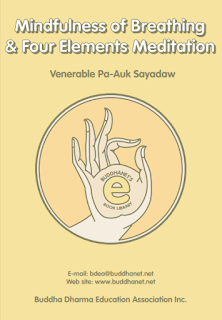 |
| These meditation devices or colorful yantras are used in Tantra to concentrate the mind |
.
The smallest "particles" of perception in Buddhist physics are called kalapas. They are, according to the "Higher Teachings" (Abhidhamma) the ultimate constituents of materiality.
 |
| Four Elements Meditation with Pa Auk Sayadaw |
One reason for this seems to be that they are not really "material" (rupa, "form") but rather somewhere in a liminal state between mind and matter.
Having spoken to people who have seen them in meditation, the obvious and annoying question they get a lot of is, Do they look anything like the atom on the high school science class poster.
The answer is an absolute, "No!" That depiction is wrong on every count and completely misleading to us as Westerners, if only we thought about it for a minute. It's a pictograph not a photo. The same is true of idealized cells.
It's controversial to say so, but it would seem that the smaller we get -- to the Buddhist pre-ancient Greek conception of an atom -- what we find is more and more subtle, less and less material, as if matter is just a gross form of mind.
In any case, a kalapa ("bundle") does not really seem to signify a material particle so much as a material quality of materiality. Imagine a bunch of blocks; it's not the blocks that are important but the qualities the different types exhibit.
How they do this leads to their classification, much like cittas (the ultimate constituents of consciousness) and mental states, defining them functionally after the fact. They don't come alone but with cetasikas,
It would all be a beautiful and worthless theory -- like the shape of our earthly world in Buddhist cosmology -- except that it can be made visible through meditation.
The foundation of such meditation is virtue (sila), which gladdens the mind and makes the "meditations" (meditative absorptions or jhanas) possible.
 |
| Four Elements Meditation (BuddhaNet.net) |
It may sound pie in the sky, but enough American meditators have done it to convince us it's not that extraordinary. It does not require enlightenment or magic powers, just a temporarily purified mind/perception that results from jhana practice.
POSTSCRIPT
You'll never hear about this stuff until you're there on retreat, paying attention and making progress. It's not talked about casually, not talked about for anyone not yet able to turn (advert) the mind as appropriate.
You may, however, be able to read about it in Four Elements Meditation or speak to teachers and former retreatants who did...if you could find them. We did, and that's why we're saying so. Otherwise, it's all good things to those who wait.
There is much to do in meditation, but in the beginning, there's nothing to do, no goal, no expectations, no ambitions, no striving or "efforting." It doesn't help; it quite harms and ruins. So sit, sit, sit with perseverance until the mind sits. Get outwardly silent until the mind becomes inwardly silent.
No comments:
Post a Comment